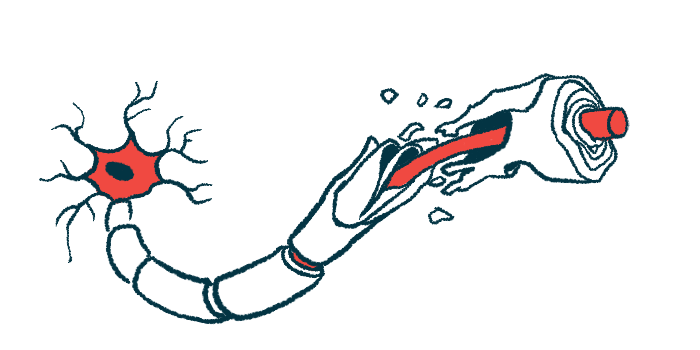Levels of 3 Inflammatory Biomarkers Linked to Worse Disease in NMOSD
Biomarkers may help monitor treatment effects, predict prognosis: study

People with neuromyelitis optica spectrum disorder (NMOSD) have increased levels in the cerebrospinal fluid (CSF) — the liquid surrounding the brain and spinal cord — of three inflammatory biomarkers, a new study shows.
The elevated concentrations of these biomarkers — YKL-40, sCD163, and sCD14 — also correlate with higher expanded disability status scale (EDSS) scores, indicating a relationship between them and more severe disease.
“In this case–control study, we confirmed that the CSF concentrations of YKL-40, sCD14, and sCD163 were increased in patients with NMOSD. Moreover, these biomarkers were all significantly associated with disease severity,” the researchers wrote.
According to the team, these biomarkers “can be used to assess the severity of NMOSD and may serve as markers to monitor the effects of treatment and predict disease prognosis.”
The study, “Microglial/macrophage activation in the cerebrospinal fluid of neuromyelitis optica spectrum disorders,” was published in Brain and Behavior.
Investigating inflammatory biomarkers in NMOSD
NMOSD is an autoimmune disease that is known to mainly affect the optic nerve and spinal cord. However, the precise mechanisms leading to nerve cell damage in people with NMOSD are still unclear.
Recent studies have shown that highly reactive microglia/macrophages are a key component of the disease. Microglia are an important type of immune cells, called macrophages, which reside in the central nervous system (CNS) — composed of the brain, spinal cord, and optic nerves — and act as a mediator of diverse immune responses.
Microglia cells are known to fight brain infections and help repair injuries. But they also have been found to cause nerve cell damage, including demyelinating lesions in the spinal cord of NMOSD patients. Such lesions cause the loss of myelin, the protective layer surrounding nerve cell fibers.
To better understand the process of microglial/macrophage activation in NMOSD, researchers in China assessed the levels of biomarkers known to be associated with neuroimmune and neuroinflammatory diseases in the CSF of NMOSD patients.
Three biomarkers were analyzed: YKL-40, sCD163, and sCD14. These are well-known to be implicated in neurological diseases, including multiple sclerosis.
“However, little is known about these biomarkers in NMOSD,” the researchers wrote.
Altogether, the team analyzed data from 154 patients. Among them, 103 were diagnosed with NMOSD, 15 with relapsing-remitting MS (RRMS), and 20 with autoimmune glial fibrillary acidic protein (GFAP) astrocytopathy, an inflammatory CNS disorder. Another 16 people with non-inflammatory neurological diseases were analyzed as controls.
There was no significant difference in age — patients had a mean age of 34 to 44 years — or sex among the groups. CSF white blood cell counts also were not significantly different between patient groups, nor were scores on the expanded disability status scale, or EDSS, a method of quantifying disability. EDSS scores were a median of 2 to 3, meaning disability but no walking impairment.
The results showed that YKL-40 levels were significantly higher in NMOSD patients [mean of 210.52 picograms (pg)/mL] than in those with RRMS (93.56 pg/mL) and controls (63.18 pg/mL). However, no significant difference was found between the NMOSD and GFAP (129.11 pg/mL) groups.
As for sCD163 and sCD14, higher concentrations also were seen in NMOSD patients compared with controls — sCD163: mean of 68.22 pg/mL in NMOSD vs. 55.76 pg/mL in controls; sCD14: 87.23 pg/mL in NMOSD vs. 58.14 pg/mL in controls.
These biomarkers were all significantly associated with disease severity
Researchers also found the disease disability scores, as assessed by EDSS, to be higher in people with NMOSD but not in the other patient groups. Those with NMOSD had increased levels of YKL-40, sCD14, and sCD163.
“In our study, the elevated levels of microglial/macrophage activation markers in the CSF of patients with NMOSD were positively correlated with EDSS scores, further indicating that microglia/macrophage activity is correlated with disease severity,” the researchers wrote.
Overall, the team concluded that the “data contribute to the growing recognition of the role of microglia/macrophages in demyelinating neuropathies such as NMOSD.”
“To the best of our knowledge, this study is the first to report changes in YKL-40, sCD14, and sCD163 levels in the CSF of patients with NMOSD,” they wrote.
Researchers noted, however, that these biomarkers also may be expressed in other inflammatory cells, “which may affect the value of our conclusions.”
Thus, further studies are needed to clarify the mechanism of microglial/macrophage activation in NMOSD, they said.






